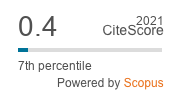Monitoring global public health threat - surveillance of Aedes (Stegomyia) mosquitoes in new Mangalore sea port, India
DOI:
https://doi.org/10.33307/entomon.v44i1.422Abstract
Vector surveillance and control at port of entry (PoE) is an essential activity for the implementation of International Health Regulations (IHR). The present study was undertaken in and around New Mangalore sea port. Inside the port area, a total of 13 water holding containers at 33 premises were checked and no containers were found positive for larval breeding. In the residential area, 132 water holding containers were checked in 100 houses. The breeding preference ratio was highest for earthen containers (18.8) followed by grinding stone (4.72), metal (1.72), cement tank (1.62) and plastic (0.24). The House index, Container index and Breteau index were found to be 7.0, 5.3 and 7.0% respectively. The nearness of residential colony to NMPT, consequently enhances the chances of spreading of Aedes mosquitoes in the port area. From the present study it is evident that inside the sea port there are ample habitats for the mosquitoes to breed and thrive in rainy season. Routine entomological surveillance is required not only to monitor the mosquito breeding in and around port area but also to prevent transportation and establishment of mosquito species in newer areas.


